How to store gladioli in winter at home
Gladioli are one of the most beautiful flowers that are successfully grown by gardeners and owners of private houses. These are undemanding plants that only need to be dug from the ground before the onset of cold weather. Summer residents need to know how to store gladioli in the winter at home, which will prevent freezing of bulbs, which are planted in flower beds next spring, are actively growing and blooming beautifully.
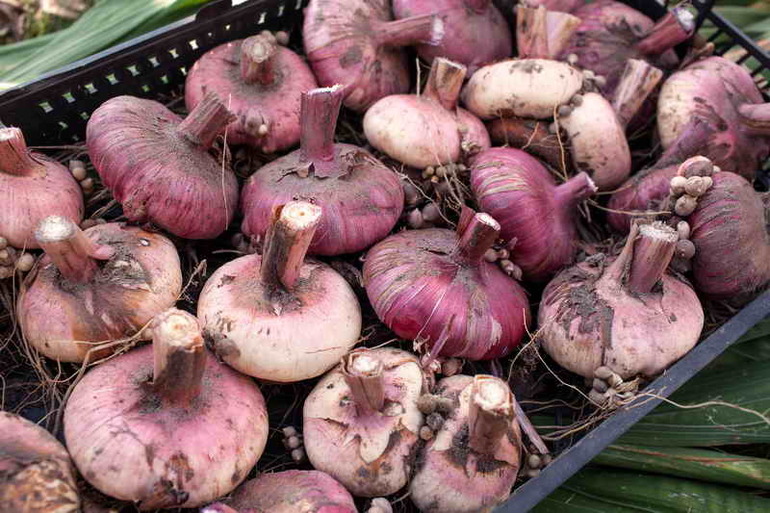
Protecting gladioli from the cold
Gladiolus, which currently has more than 2,000 different species, is a southern plant, so it is extremely sensitive to cold. When the soil temperature drops to minus 3 degrees, the bulb dies, and subsequently it will be impossible to restore the plant. That is why it is necessary to dig out gladioli properly before the onset of cold weather, and the subsequent storage of gladioli bulbs at home in winter will not be particularly difficult.
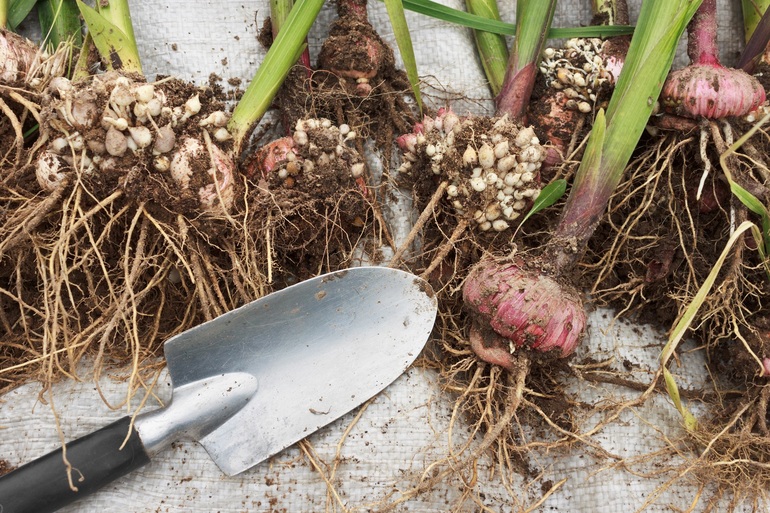
Digging out gladioli is a responsible and important process for each owner of a private house and summer cottage. The state of planting material will subsequently depend on the correctness of such work. Bulbs should be dug in early autumn, usually 25–40 days after the last cut of flowers. By this time, air and soil temperatures will not yet be negative, tubers are not affected by the cold, and all that remains to be done is to properly store them.
Often flower growers make a common mistake, dig up tubers, but subsequently store them in a cold cellar or in a wet basement, where such bulbs rot and quickly deteriorate. Experienced gardeners recommend dividing gladioli by grades, providing optimal temperature and humidity indicators during their storage in the winter season.
Optimal procedure time
There is no consensus on when to dig the gladiolus bulbs today. It is necessary to take into account the specific variety of these flowers, as well as climatic conditions in the region. Usually this is the second half of September, by this time it takes about 35-40 days after flowering. In no case should not be delayed with the digging of plants, since in the cold earth the plants quickly freeze, and in the future such necrosis spreads throughout the bulb.
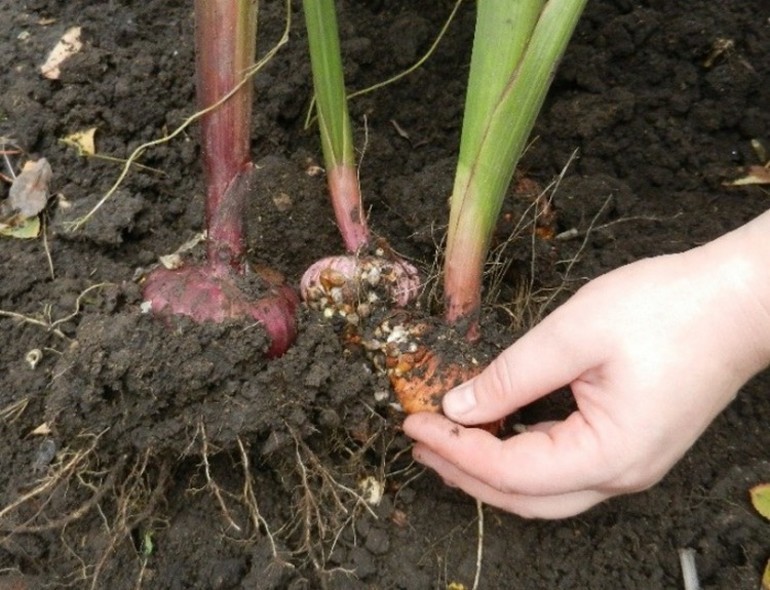
Bulb maturation can be determined by carefully digging it from the soil and inspecting for the presence of integumentary flakes. If such protective plates appeared in small tubers, then gladioli should be immediately excavated from the soil, properly cleared of them from the ground, dried under the sun and laid down for preservation.
When carrying out such work, one should take into account its following features:
- all work is carried out either with a garden shovel or with special flower forks;
- first they dig large bulbs, then small ones and at the very end small children-seeds are removed from the ground;
- Such work should be carried out on a warm sunny day, but not in the rain;
- it is best to dig out gladioli a few days after heavy rain.
Gardeners who plant gladioli on a garden plot need to monitor the weather forecast to prevent freezing of plants.Any early frosts will be detrimental to corms, therefore, during a period of lowering temperature, they should be covered with a film or mulch the beds with a thick layer of organics.
Proper digging from the ground
When digging up tubers, it is necessary to observe maximum accuracy, first a bush is dug up, which will allow you to stretch plants with large bulbs. To do this, you can use a small wide garden shovel or small villas, which will allow you to dig out all the children from the soil. When working on the ground, they maintain maximum accuracy, since any damage to the bulb will not allow it to be subsequently used for re-planting.
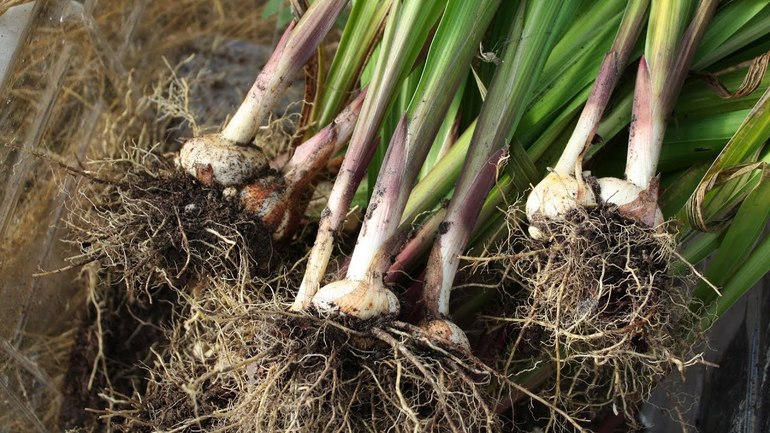
All bulbs removed from the ground should be shaken off the ground, while dipping their water or rinsing under a hose is not recommended. With the help of a disinfected secateurs, all excess leaves are cut off. It is through the foliage from the bulbs of gladioli that moisture evaporates, which leads to their drying out and subsequent rapid death.
The gardener needs to equip an improvised canopy in the open air and dry the bulbs in the open air for 5-7 days. Such preliminary drying is carried out exclusively at positive temperatures, and if cooling is approaching, then the planting material of flowers is transferred to a heated room. High-quality drying in the future will prevent the appearance of decay, the bulbs can easily withstand winter storage and in the spring after planting they will sprout together in a flower bed.
Preparing bulbs for winter
Storage of bulbs of gladioli in the winter season is not particularly difficult. It is only necessary to correctly determine the timing of their excavation from the soil, and in the subsequent strictly observe all the main stages of such work.
Preparation of bulbs for winter storage takes place in several stages:
- timely cleaning of plants;
- foliage trimming;
- peeling and drying of bulbs;
- proper processing before bookmark storage.
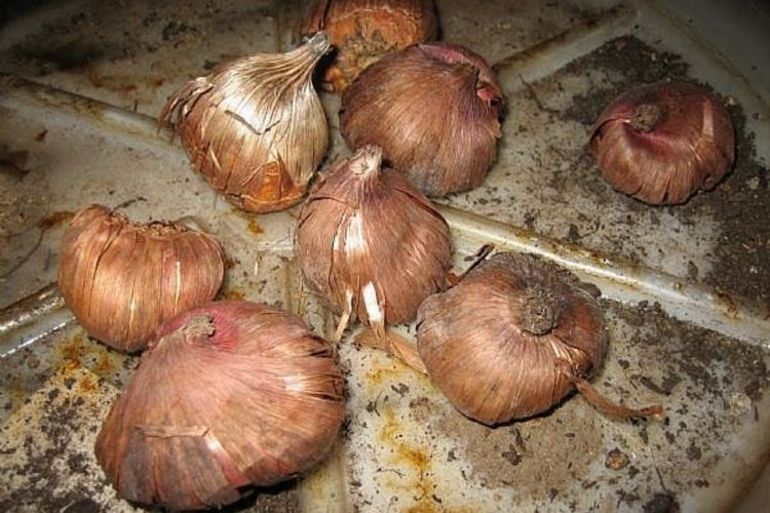
After drying in the open air or in a dry, ventilated area, the old shell should be carefully removed from the bulbs without damaging the bottom. It is from it that the roots of flowers begin to sprout later.
The tubers are disinfected, for which they are soaked for 30 minutes in a solution of pink potassium permanganate or Fundazole. This will destroy the various infectious pathogens, improving the subsequent storage of planting material.
After disinfection and removal of the old shell, the onions are again dried, for which they are kept for 30–40 days in a room with room temperature. This procedure is required, as it prevents the appearance of a fungus, which often manifests itself during the winter drying of tubers.
Storage options
There are several ways to store corms of gladioli, which allows them to be stored until spring, and subsequently such plants, after they are planted in warm, prepared soil, quickly germinate and bloom perfectly.
Storage of gladioli for the winter at home is possible:
- on the bottom shelf of the refrigerator;
- in a warm ventilated cellar;
- inside the earthen trench;
- at home.
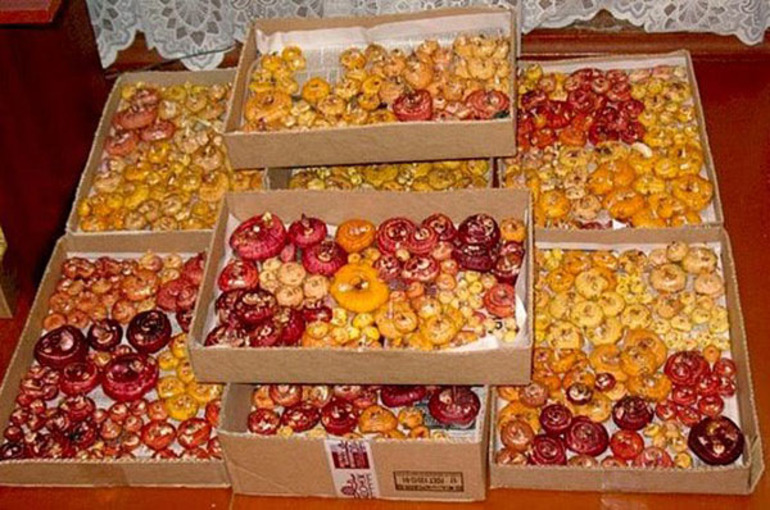
The easiest way to keep gladioli in the winter is in an apartment on the bottom shelf of the refrigerator. The temperature here usually does not fall below 2-3 degrees of heat, while there is the possibility of regular inspection and monitoring of the condition of planting material. Before laying the onions in the refrigerator for long-term storage, they are carefully dried, and then wrapped in a dry newspaper. For ventilation, small centimeter holes are made in the paper, after which the tubers are carefully placed in an open plastic bag or plastic container.
A dry and cool cellar with good ventilation will be a great place to store bulbous flowers.It should only be remembered that, in addition to flower tubers, in such a small room other vegetables and fruits should not be stored that will release moisture, which provokes the appearance of fungus and mold. The optimal temperature for gladioli in winter will be a range of 4−7 degrees, humidity indicators should fluctuate between 60−70%. Bulbs can be stored in a wooden box, while the tubers should not be placed at the very bottom of the container.
Inside the trench, tubers are only allowed to be stored in the southern regions where there are no frosty winters. Such protective structures are made of lumber, which are deepened by 30-40 centimeters. Their arrangement should be completed before the onset of cold weather, after which they carefully lay the dried onions, pouring them on top with any organic and sawdust, additionally covering them with fir spruce branches.
It will be problematic to save gladioluses in winter at home, as it is difficult to find a place in the apartment where there would be no sudden temperature changes. The moisture content during such storage should be 60–70%. The optimum temperature is 5-10 degrees.
This can be a glazed insulated loggia in a city apartment, the space between window frames or an unheated pantry.
Recommendations to gardeners
Often tubers of gladioli during their winter storage damage pests thripsthat feed on the juice of bulbs, which leads to the rapid death of plants. As a prophylaxis for the appearance of such insects, all planting material is processed using the Hom preparation before its laying for storage.
Experienced flower growers recommend sprinkling them several times with any powders from cockroaches to protect against thrips before laying tubers for the winter. This procedure is performed 2-3 times, and in the subsequent one more pubescence is carried out immediately during storage in early January.
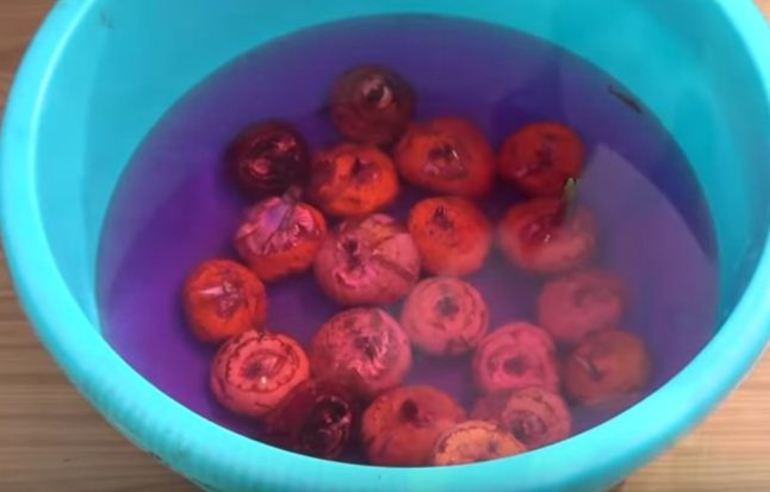
You can prevent the development of mold by treating the bulbs with Maxim or self-prepared disinfection solutions. The main reason for the appearance of the fungus is the non-compliance with temperature and wet storage conditions, as well as insufficient drying of planting material after it is removed from the ground. To prevent this, each bulb should be wrapped in paper, which will subsequently absorb moisture.
Gladioli are decorative, easy-to-care beautiful flowers that are often planted in flower beds in summer cottages or in the adjoining territory of private houses. It is not economically feasible to buy new bulbs every spring in the spring, so many gardeners dig up planting material before the onset of cold weather, and its subsequent storage in the cellar, on a glazed loggia or in a dry, warm basement will not be particularly difficult. You just need to know at what temperature and humidity such a planting material can withstand.
- How to choose a vacuum cleaner taking into account the characteristics of the house and coatings?
- What to look for when choosing a water delivery
- How to quickly create comfort at home - tips for housewives
- How to choose the perfect TV - useful tips
- What to look for when choosing blinds
- What should be running shoes?
- What useful things can you buy in a hardware store
- Iphone 11 pro max review
- Than iPhone is better than Android smartphones



